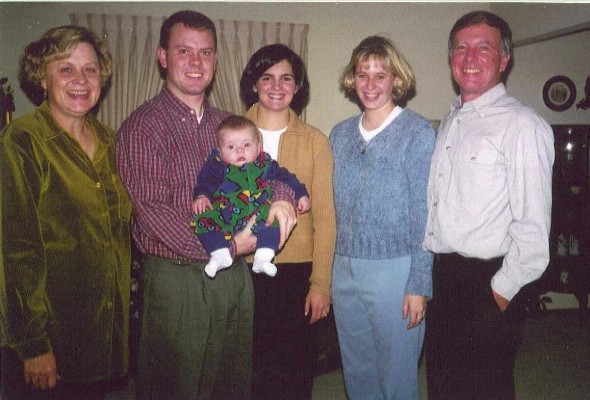The Last One You’d Predict to Have Cancer
Even into his sixties, Patrick O'Neil was not ready to stop. He loved his job, which he helped forge in 1973 as one of the founders of O'Neil, Cannon, Hollman, DeJong, S.C., a law firm that represents parties in major domestic and international business transactions. His colleagues agreed that Pat was "unparalleled in creativity and passion" making him "one of the best in the business." With Pat's help, the firm grew over the years and is now one of the largest firms in the Milwaukee area. As the firm's elder, Pat was instrumental in guiding the firm. However, he was never concerned with growth. At the end of the day, Pat just wanted to be with his family, his loving wife, Barbara, and two children, son Michael and daughter Regan.
Pat's love for law extended from his practice to the classroom where he lectured frequently and occasionally served as an associate professor. It was all "fun" for him and even on vacation he longed to get back to work. Barbara said that he couldn't be away for more than a week, "he wasn't one to sit around a club house with the boys. He wanted to do things." Pat was strong, independent, and self-reliant. He enjoyed staying busy and feared retirement because he "wouldn't know how to do nothing." Always on the move, when Pat wasn't working, he was outside playing. He was an avid golfer, water skier, hiker, and downhill skier. At one time he was an elite level racquetball player. Recreation was a way to keep in shape, and Pat was always concerned about his health, never overweight and always physically fit.
Despite his tough-guy exterior that he put on at times, his friends say that underneath he had a heart of gold. Everyone knew his family was his first priority. Pat and Barbara were true companions and they enjoyed everything together from traveling to their vacation spot in Florida to attending local plays and social events around town. Pat lived for his two children who loved sports when they were young. That's why, in 1985, Pat helped found the Mequon Soccer Club. He was always in the bleachers at Michael's soccer games and cheered Regan on as she hit the ball out of the park in softball. When his own children had kids of their own, Pat and Barbara found a new joy in life. He adored his grandchildren, Jack and Caitlyn.

Even though Patrick was a grandfather, Barbara saw her husband as only perfect health. She said, "if you lined up twenty 61 year-olds, Pat would be the last you'd predict to come down with cancer." However, in the fall of 2004, when Pat was 62 years old, he began having problems breathing. Eventually it worsened, and Pat saw his primary care physician who ordered an X-ray to better detect what might be hindering his breathing. The chest films revealed a pleural effusion, and Pat quickly found himself at Columbia St. Mary's Hospital in Milwaukee, Wisconsin where he underwent a thoracentesis to remove the 3 liters of fluid build up in his chest and a talc pleurodesis to prevent further fluid accumulation. After more tests such as a chest film and biopsy of the mass, Pat was diagnosed with malignant mesothelioma. Pathologists later confirmed the diagnosis at the Mayo Clinic in Rochester, Minnesota. His family lost no time in finding the most qualified doctors to treat Pat.
Pat's son Michael is also a lawyer in Milwaukee and while researching treatment options, he found Dr. David Sugarbaker, surgical oncologist at Brigham and Women's Hospital in Boston, Massachusetts. By November 2004, Pat met and consulted with Dr. Sugarbaker who felt that Pat was a good candidate for the tri-modal therapy program which included an extra-pleural pneumonectomy (EPP). Under this protocol, Pat would have the radical EPP to remove the affected lung entirely and then follow up with chemotherapy and radiation to further eradicate the mesothelioma.
Patrick's family physician thought the surgery was in fact too radical and did not encourage him to proceed. Still, Pat thought he might be able to get at least another four years if he got the treatment. So, on December 22, 2004, he underwent the EPP in Boston. Afterwards, Dr. Sugarbaker assured them that "everything look[ed] like we got longevity. Went very well. Very successful." However, all was not well. Patrick remained in Boston for two months. He was hospitalized on and off over eight weeks due to repeated events of atrial fibrillation. According to Barbara, the eight weeks were "hell."

Once Pat built his strength up, he began several rounds of chemotherapy and radiation treatments. In March 2005, Pat and Barbara returned home. Soon Pat began to gain more strength and returned to work for a period of time. This was short-lived though. In August, he began to have discomfort in his stomach. After undergoing additional tests, Pat's oncologist informed him that the mesothelioma had spread to his stomach.
A Wake-up Call
This was devastating news. According to Barbara, Pat was reading at the time of the telephone call (he loved to read; it was his escape from his own grim reality). When he got the news, he said "I can't believe I don't have more time. I thought I had at least three years. But I've got only a few months." Pat was never one to dwell on the negatives, and so he said nothing more about it. Instead, he tried to immerse himself in work even more to avoid thinking about what might happen.
Pat continued to worsen rapidly. On November 30, 2005, nearly one year after his diagnosis, Pat passed away. His absence has been hard for the entire family. His wife feels alone and like many others who have lost their loved ones too soon, she is angry about a pain she can't seem to touch or heal or avoid. The O'Neils had planned on growing much more grey together. They had looked forward to years of travel and play with their grandchildren.
Barbara fills the void by staying busy with family. She seeks solace with her children and grandchildren. Spending time with them has proven to be a light through this difficult time.

***POSTED DECEMBER 28, 2006 ***


